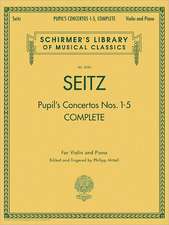A History of the Concerto: Amadeus
Autor Michael T. Roederen Limba Engleză Paperback – 28 feb 2003
Din seria Amadeus
-
 Preț: 467.92 lei
Preț: 467.92 lei -
 Preț: 295.62 lei
Preț: 295.62 lei -
 Preț: 108.95 lei
Preț: 108.95 lei -
 Preț: 312.42 lei
Preț: 312.42 lei -
 Preț: 222.18 lei
Preț: 222.18 lei -
 Preț: 284.22 lei
Preț: 284.22 lei -
 Preț: 244.45 lei
Preț: 244.45 lei -
 Preț: 254.21 lei
Preț: 254.21 lei -
 Preț: 163.91 lei
Preț: 163.91 lei -
 Preț: 315.47 lei
Preț: 315.47 lei -
 Preț: 284.82 lei
Preț: 284.82 lei -
 Preț: 222.18 lei
Preț: 222.18 lei -
 Preț: 328.31 lei
Preț: 328.31 lei -
 Preț: 245.34 lei
Preț: 245.34 lei -
 Preț: 242.54 lei
Preț: 242.54 lei -
 Preț: 427.69 lei
Preț: 427.69 lei -
 Preț: 476.54 lei
Preț: 476.54 lei -
 Preț: 284.99 lei
Preț: 284.99 lei -
 Preț: 234.01 lei
Preț: 234.01 lei -
 Preț: 317.59 lei
Preț: 317.59 lei -
 Preț: 284.22 lei
Preț: 284.22 lei -
 Preț: 236.78 lei
Preț: 236.78 lei -
 Preț: 238.73 lei
Preț: 238.73 lei -
 Preț: 248.51 lei
Preț: 248.51 lei -
 Preț: 278.67 lei
Preț: 278.67 lei -
 Preț: 239.83 lei
Preț: 239.83 lei -
 Preț: 211.20 lei
Preț: 211.20 lei -
 Preț: 155.60 lei
Preț: 155.60 lei -
 Preț: 249.08 lei
Preț: 249.08 lei -
 Preț: 335.70 lei
Preț: 335.70 lei -
 Preț: 238.69 lei
Preț: 238.69 lei -
 Preț: 217.52 lei
Preț: 217.52 lei -
 Preț: 214.63 lei
Preț: 214.63 lei - 48%
 Preț: 108.64 lei
Preț: 108.64 lei - 24%
 Preț: 232.10 lei
Preț: 232.10 lei - 29%
 Preț: 149.37 lei
Preț: 149.37 lei - 31%
 Preț: 173.63 lei
Preț: 173.63 lei - 46%
 Preț: 134.99 lei
Preț: 134.99 lei - 20%
 Preț: 137.51 lei
Preț: 137.51 lei
Preț: 405.64 lei
Nou
Puncte Express: 608
Preț estimativ în valută:
77.63€ • 80.75$ • 64.09£
77.63€ • 80.75$ • 64.09£
Carte tipărită la comandă
Livrare economică 14-28 aprilie
Preluare comenzi: 021 569.72.76
Specificații
ISBN-13: 9780931340611
ISBN-10: 0931340616
Pagini: 484
Dimensiuni: 208 x 277 x 28 mm
Greutate: 1.09 kg
Ediția:New.
Editura: Amadeus Press
Seria Amadeus
ISBN-10: 0931340616
Pagini: 484
Dimensiuni: 208 x 277 x 28 mm
Greutate: 1.09 kg
Ediția:New.
Editura: Amadeus Press
Seria Amadeus
Textul de pe ultima copertă
Michael Roeder's A History of the Concerto traces the concerto from its origins in the sixteenth and seventeenth centuries to its incarnation in the present. Basic to the concerto idea is the division of the performance group into two parts - one solo and the other orchestral - but the relationships between these two have undergone fundamental changes over the centuries. In many of the more familiar works from the nineteenth century, the composer frequently juxtaposes a dazzling soloist against a more conservative orchestral voice, but this has not always been the case. The developing concerto form, while always maintaining the dramatic opposition of solo and orchestral forces, evolved many rich variations specific to time, place, and composer. Whether in Vivaldi's The Four Seasons, Beethoven's "Emperor", or Calandrelli's Concerto for Jazz Clarinet, the dual elements of cooperation and contention come into play. The changing role of the soloist; the development of instruments; the evolution of music's function in society; the influence of local, regional, and international culture; and the composer's individual story are all part of Roeder's documentation of concerto history. The book is divided into four sections corresponding to the major historical-stylistic periods of Western music and of concerto development - Baroque, Classical, Romantic, and Twentieth Century. Within these sections, attention is given to geographical regions where strikingly different approaches to concerto style are found. Roeder explores major works as well as the pieces of lesser-known composers whose contributions were important to the changing character of the concerto. A History of the Concerto may be readfrom cover to cover, but readers may also use the extensive index to focus on specific concertos and their composers. Numerous musical examples illuminate critical points. While some readers may want to study the more detailed analyses with scores in hand, this is not essential for an understanding of the text. Michael Roeder's lucid and detailed historical study of the concerto will inform and delight those interested in understanding this popular and dynamic musical form.
Notă biografică
By Michael Thomas Roeder














